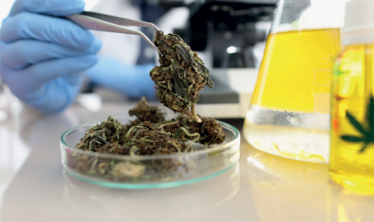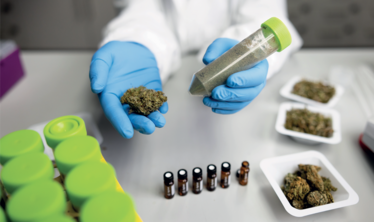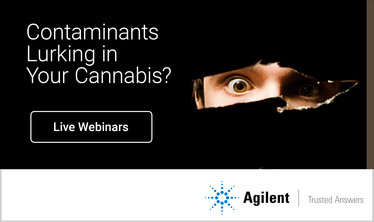
How to Achieve Pharma-Grade Cannabis Quality
Meeting pharmaceutical GMP standards for medical cannabis presents significant analytical challenges given the wide variability and deep complexity of plant matrices. Here, Connor Murphy, COO and Co-Founder of QNTM Labs, walks us through the pitfalls – and presents one solution.
| 6 min read
sponsored by Agilent Technologies

In several markets, especially in the EU, cannabis is regulated as a pharmaceutical product in accordance with EU Good Manufacturing Practice (GMP) guidelines. These guidelines focus on quality but can be difficult to navigate for companies developing and producing cannabis-based products. Denmark-based QNTM Labs is a leading provider of pharmaceutical method development and validation across chemical and microbiological analysis for small molecule formulations, including cannabis-based regulated medicines, and it is one of the only EU-GMP quality control labs that can handle compliant cannabis testing in a single location.
Here, we speak with Connor Murphy, COO and Co-Founder of QNTM Labs, about the challenges in the analysis of pesticide residues in cannabis flowers (flos), and how QNTM has worked with Agilent, for navigating testing regulations of cannabinoid-based medicines in the EU.
What services do QNTM Labs provide to help overcome these challenges?
QNTM Labs is a huge GMP contract pharma laboratory that provides stability studies, process controls, method development, validation, and professional scientific services. We handle batch release and routine analysis for products that have already been through marketing authorization; but actually deliver most value for customers in both preclinical and clinical development settings. Our internal processes are digital and designed for the flexibility needed by manufacturers in formulation and development. Also, our team is made up of experienced specialists that have worked across development, production, and contract services.
We recognize that the pharma contract lab market has shifted into a lean, mean, batch release production machine to take in a large number of samples and push out results quickly. However, with advancing technology and scientific discoveries in biotech and pharma modern medicine alongside compliance oversight and data requirements, we’ve found that more companies in these industries want to work under EU GMP guidelines and think about the future of their products. With this in mind, we’ve made an effort to sit down with teams of chemists and microbiologists on the clinical and production sides companies to discuss the best path to getting a registered product. By focusing on preclinical and clinical development with a robust lab, we’ve been driving a ton of value for our customers.
What are the pitfalls for cannabis analysis in a pharmaceutical setting?
The main difficulty with bringing cannabis into a pharma setting is specification within your analysis. Traditional pharma isolates singular molecules per drug for very specific and defined analysis. If you look at cannabis flos in its most basic sense, we find a natural product with over 150 cannabinoids, hundreds of terpenes, and many other endogenous compounds. Adding to this complexity is the presence of exogenous compounds, such as pesticide residues. With such a complex product, you need to identify, quantify, measure, and document all the key target analytes.
This task is particularly difficult in a material matrix that isn’t homogenous. Not only does it degrade, but the sticky texture in its final form – including oils and extracts – can lead to additional variability. In pharma, variability is not tolerated. There must be control and an understanding of exactly what you’re doing and what the expected result should be.
For pesticide residue analysis, there are over 100 different pesticide compounds that need to be identified then quantified at extremely low limits of detection across multiple workflows. For example, the sample prep required to get a clean analyte that maintains the potential pesticide compounds yet removes all of the other compounds present in the plant matrix is difficult. Then, to take that analyte and run it through workflows that are sensitive enough to identify and quantify all relevant pesticides in single runs and comply with EU-GMP validation standards… It's quite a challenge!
When it comes to production, ensuring that every batch coming off the production line meets strict standards is the goal – but it is far from easy. But as we get more refined with extracts and oils moving down into a pure isolate or a single cannabinoid in a product, the less complicated things become. Working with cannabis flos as a pharmaceutical product admittedly feels like trying to put a square peg into a round hole – products with a single cannabinoid (THC, CBD, etc.) would fit much better as APIs.

Why have you chosen to work with Agilent for the analysis of cannabis flos?
The nature of cannabis analysis involves a broad scope of research and, especially in pharma, companies often need to use various labs across the world to get their product released. Agilent provides us with key instrumentation that cuts out the back and forth to various providers. For us working in EU GMP compliance for products in early-stage development through batch release, it’s important that we can conduct analysis in one place and handle data effectively. Agilent’s unified analytical platforms and support team have been a key piece of the puzzle to allow QNTM Labs to deliver the right service.
How does cannabis analysis in pharma differ to that conducted in other areas, such as food and agriculture?
They differ in the exact same way that analysis requirements of spinach differ from analysis requirements of insulin! Requirements in pharma are much more intensive than requirements in food – stricter data requirements, more specific workflows, all qualified instruments, all validated methods, and so on.
In other words, the pharma market has very strict compliance standards, which, as we’ve discussed, can create some challenges. However, by following protocol in an EU GMP environment (or similar regulations depending on which country you’re based in), your equipment, processes, software, and validation methods all work together to ensure that you’re achieving precise results in each area of analysis. The result is greater confidence for producers and manufacturers; they know they are providing high-quality raw materials and products to ensure consumer safety and satisfaction, as well as maintaining brand integrity.
What are your top tips for navigating cannabis testing regulations?
Especially within the European market, it’s crucial to put pharma at the forefront of your mind. The European cannabis testing market is a pharma market and without navigating necessary European Pharmacopoeia regulations and working with an experienced team, is unrealistic.
By partnering with a contract manufacturer with a turnkey solution in house, pharma production companies working on cannabinoid-based products don’t have to export products to various markets. Not only does this help with the regulatory aspect, but it also assists in meeting specifications and understanding the overall product.
What regulatory developments would you like to see in the cannabis testing space?
I’d like to see a standardized European Pharmacopoeia that’s specific to product type. We are getting closer to this being rolled out, but there’s still variations in production in different countries that are meeting alternative requirements. In an already complex product matrix and new environment, this adds another layer of complexity that has to be managed.
For us, all of our workflows already adhere to the European Pharmacopoeia – this is where analytical methods for pharma products come from. In addition, our pesticides workflow is made specifically to comply with the European Pharmacopoeia.
Want to find out more about European Pharmacopeia compliant solutions for contaminant detection in cannabis flos?
Agilent products and solutions are intended to be used for cannabis quality control and safety testing in laboratories where such use is permitted under state/country law













